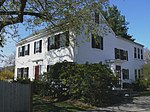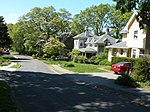Joseph Remick House

The Joseph Remick House is a historic house in Winchester, Massachusetts. The two story stucco-clad house was built in 1909 by Joseph Remick, and is sometimes called the "Baby Sanborn House" for its resemblance to the much larger Sanborn House just down the road. The house has a central five-bay section, which is flanked by wings that are one story in front and two in back. The main section is five bays wide, with French windows on both floors. The center three on the first floor are topped by triangular pediments, while those on the second floor have keystones set just below a Greek key frieze. A balustrade rings the flat roof.The house was listed on the National Register of Historic Places in 1989.
Excerpt from the Wikipedia article Joseph Remick House (License: CC BY-SA 3.0, Authors, Images).Joseph Remick House
Swan Road,
Geographical coordinates (GPS) Address Nearby Places Show on map
Geographical coordinates (GPS)
| Latitude | Longitude |
|---|---|
| N 42.443611111111 ° | E -71.153055555556 ° |
Address
Swan Road 4
01890
Massachusetts, United States
Open on Google Maps











